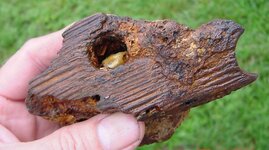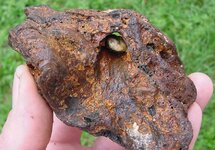Bigcypresshunter
Gold Member
- Dec 15, 2004
- 27,000
- 3,339
- Detector(s) used
- 70's Whites TM Amphibian, HH Pulse, Ace 250
- Primary Interest:
- Beach & Shallow Water Hunting
I found this at lo-tide Thursday on one of the Treasure Coast 1715 shipwreck sites rolling in the surf. It looks like wood but is heavy as a rock. ...hard too. Has a large nailhole in the center and another hole on the right side. It also sinks like a rock. What is it? Could this be shipwreck wood? Why is it so heavy and hard?





 Perhaps.
Perhaps.  Thanks Deepsky and Old Dog. I knew TN could get it solved.
Thanks Deepsky and Old Dog. I knew TN could get it solved.  Lignumvitae or Ironwood does grow native in the Florida Keys, along with Mahoghany, and the larger trees were logged extensively for early shipbuilding. I believe a Florida key is named Lignumvitae Key and is now a protected park.
Lignumvitae or Ironwood does grow native in the Florida Keys, along with Mahoghany, and the larger trees were logged extensively for early shipbuilding. I believe a Florida key is named Lignumvitae Key and is now a protected park.